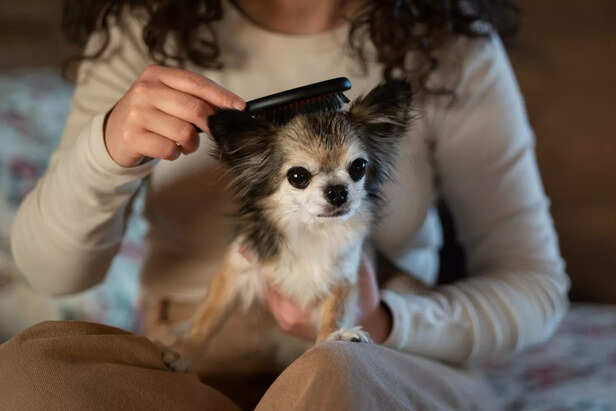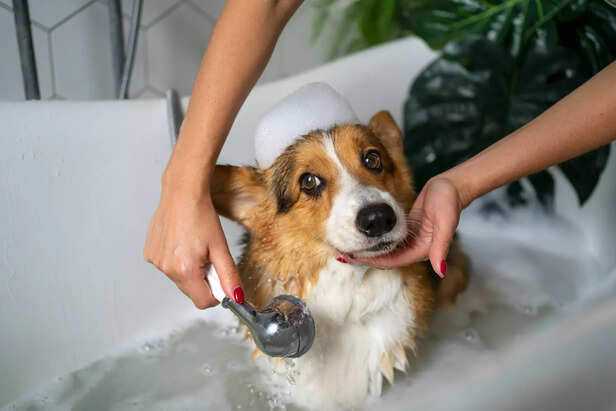How to Keep Your Pet’s Coat Shiny and Healthy
Nikita Kanyal | Dec 05, 2024, 22:08 IST
(Image Source : Pixabay)
Uncover the definitive guide to maintaining your pet’s fur shiny and healthy! Covering everything you need to understand, this article includes a balanced, nutrient-dense diet, adequate grooming, hydration, and natural treatments. Find out how exercise, pest control, and regular veterinary examinations play a role in achieving a lustrous coat, making sure your furry companion appears and feels their finest throughout the year.
When you imagine a joyful, healthy pet, what’s the initial thought that enters your mind? For numerous individuals, it’s the image of a lustrous, shiny coat that seemingly radiates in the sunlight. A healthy coat is not just an aesthetic trait—it’s a clear indication of your pet’s general health. But how do you achieve that luscious fur your pet deserves?
Did you know that your pet’s diet plays the biggest role in their coat’s health? Just like humans need proper nutrition for glowing skin, your pet needs a balanced diet for a healthy coat. Look for pet food that has elevated amounts of omega-3 and omega-6 fatty acids, as these are essential for maintaining skin moisture and reducing inflammation. Choices that are rich in these advantageous fats include salmon, sardines, and flaxseed oil. If your pet's regular diet does not supply these nutrients, specific supplements formulated for pets also contain them.
Furthermore, protein is essential! A lustrous coat originates from inside, and protein serves as the foundation for robust, healthy fur. When your pet's diet is deficient in protein, their coat might turn dull, dry, or more likely to shed. Speak with your veterinarian to confirm that your pet's food is fulfilling their nutritional requirements.
Quick Tip: Avoid foods with excessive fillers like corn or soy. These can lead to poor coat quality and even skin allergies.

If you want a shiny coat, grooming needs to be part of your routine. Brushing isn’t just for show; it stimulates your pet’s skin, promotes natural oil production, and prevents tangles and mats. For dogs, a good brushing session a few times a week can work wonders. Choose a brush suited to your pet’s coat type—slicker brushes for long-haired breeds and bristle brushes for short-haired ones.
Cats also benefit from regular grooming, especially if they’re long-haired breeds like Persians or Maine Coons. Brushing your cat prevents hairballs and keeps their coat free of debris and shedding hair.
Bonus Benefit: Grooming sessions strengthen your bond with your pet, turning it into a relaxing and enjoyable experience for both of you.
Fleas, ticks, and other parasites are your pet’s coat’s worst enemies. Not only do they cause constant itching and discomfort, but they can also lead to patchy fur loss and skin infections. Regular flea and tick prevention is a must. Whether you prefer monthly topical treatments, oral medications, or flea collars, keeping parasites at bay will ensure your pet’s coat stays in top shape. If you notice excessive scratching or flaky skin, consult your vet to rule out parasites or allergies.
Hydration isn’t just for quenching thirst; it’s a crucial factor in maintaining a soft, shiny coat. Pets that don’t drink enough water often have dry, flaky skin, which directly affects their coat. Make sure your pet always has access to fresh, clean water. If you struggle to get them to drink enough, try switching to a wet food diet or adding a pet-safe broth to their meals.
For cats, consider investing in a water fountain. Cats are naturally drawn to moving water, and a fountain can encourage them to drink more.

While consistent bathing is important, excessive bathing can deplete your pet’s coat of its natural oils, resulting in dryness and dullness. So how frequently should you wash your furry companion? For the majority of dogs, bathing every 4–6 weeks is optimal, although this may differ based on their breed and lifestyle. If your dog enjoys spending a lot of time outside or has a penchant for rolling in mud, you may need to wash them more frequently.
Conversely, cats seldom require baths. They are inherently self-cleaning creatures, but for long-haired or elderly cats, an occasional bath may be required. Use a pet-safe shampoo that’s designed to moisturize and nourish the skin. Avoid human shampoos, as these can disrupt your pet’s skin pH and cause irritation. You can even find shampoos infused with oatmeal or aloe vera for extra hydration.
Pro Tip: Always condition after shampooing to lock in moisture and boost shine.
Sometimes, your pet’s coat needs a little extra TLC, and natural oils can work wonders. Coconut oil, for instance, is a miracle worker for dry, flaky skin. You can apply a small amount directly to their coat or mix it into their food for added benefits.
Fish oil is another excellent option, loaded with omega-3 fatty acids that nourish from the inside out. Adding a vet-approved fish oil supplement to their meals can dramatically improve coat shine over time.
Caution: Always use oils in moderation and consult your vet before adding supplements to your pet’s diet.

Believe it or not, regular exercise contributes to a shiny coat. Exercise improves blood circulation, which nourishes the skin and hair follicles. A healthy body leads to a healthier coat, so get your pet moving! Dogs love long walks, playtime at the park, or even swimming sessions. For cats, interactive toys like feather wands or laser pointers can encourage physical activity. Plus, exercise reduces stress, which can otherwise cause shedding and dullness in pets. A happy pet equals a beautiful coat!
If your pet’s coat still looks dull despite your best efforts, underlying allergies or skin conditions might be to blame. Common allergens include certain foods, environmental factors like pollen, or even grooming products.
Signs of allergies include excessive scratching, redness, or flaky skin. If you notice these symptoms, consult your vet immediately. They may recommend a hypoallergenic diet or special medicated shampoos to restore your pet’s coat to its former glory.
9. Don’t Forget About Seasonal Care
Changes in seasons can affect your pet’s coat. Winter weather, for example, can lead to dry, flaky skin, while summer brings its own set of challenges like shedding and sunburn (yes, pets can get sunburned too!).
During winter, consider using a humidifier to prevent skin dryness, and don’t forget to groom regularly to remove dead hair. In the summer, keep your pet hydrated and protected from harsh UV rays. If they’re spending time outdoors, use a pet-safe sunscreen, especially for pets with light-colored fur.

Last but certainly not least, regular vet checkups are essential for a shiny, healthy coat. Your vet can help identify any underlying health issues that may be affecting your pet’s skin and fur.
Whether it’s a nutritional deficiency, hormonal imbalance, or something more serious, catching these issues early will make all the difference. Plus, your vet can provide personalized recommendations tailored to your pet’s specific needs.
1. Feed Them a Coat-Boosting Diet
Furthermore, protein is essential! A lustrous coat originates from inside, and protein serves as the foundation for robust, healthy fur. When your pet's diet is deficient in protein, their coat might turn dull, dry, or more likely to shed. Speak with your veterinarian to confirm that your pet's food is fulfilling their nutritional requirements.
Quick Tip: Avoid foods with excessive fillers like corn or soy. These can lead to poor coat quality and even skin allergies.
2. Regular Grooming Is Non-Negotiable

Grooming is the key (Image Source : Freepik)
If you want a shiny coat, grooming needs to be part of your routine. Brushing isn’t just for show; it stimulates your pet’s skin, promotes natural oil production, and prevents tangles and mats. For dogs, a good brushing session a few times a week can work wonders. Choose a brush suited to your pet’s coat type—slicker brushes for long-haired breeds and bristle brushes for short-haired ones.
Cats also benefit from regular grooming, especially if they’re long-haired breeds like Persians or Maine Coons. Brushing your cat prevents hairballs and keeps their coat free of debris and shedding hair.
Bonus Benefit: Grooming sessions strengthen your bond with your pet, turning it into a relaxing and enjoyable experience for both of you.
3. Protect Them From Pests
Fleas, ticks, and other parasites are your pet’s coat’s worst enemies. Not only do they cause constant itching and discomfort, but they can also lead to patchy fur loss and skin infections. Regular flea and tick prevention is a must. Whether you prefer monthly topical treatments, oral medications, or flea collars, keeping parasites at bay will ensure your pet’s coat stays in top shape. If you notice excessive scratching or flaky skin, consult your vet to rule out parasites or allergies.
4. Keep Hydration Levels in Check
Hydration isn’t just for quenching thirst; it’s a crucial factor in maintaining a soft, shiny coat. Pets that don’t drink enough water often have dry, flaky skin, which directly affects their coat. Make sure your pet always has access to fresh, clean water. If you struggle to get them to drink enough, try switching to a wet food diet or adding a pet-safe broth to their meals.
For cats, consider investing in a water fountain. Cats are naturally drawn to moving water, and a fountain can encourage them to drink more.
5. Bathing the Right Way

Keep your pet clean (Image Source : Pixabay)
While consistent bathing is important, excessive bathing can deplete your pet’s coat of its natural oils, resulting in dryness and dullness. So how frequently should you wash your furry companion? For the majority of dogs, bathing every 4–6 weeks is optimal, although this may differ based on their breed and lifestyle. If your dog enjoys spending a lot of time outside or has a penchant for rolling in mud, you may need to wash them more frequently.
Conversely, cats seldom require baths. They are inherently self-cleaning creatures, but for long-haired or elderly cats, an occasional bath may be required. Use a pet-safe shampoo that’s designed to moisturize and nourish the skin. Avoid human shampoos, as these can disrupt your pet’s skin pH and cause irritation. You can even find shampoos infused with oatmeal or aloe vera for extra hydration.
Pro Tip: Always condition after shampooing to lock in moisture and boost shine.
6. Pamper Them with Natural Oils
Fish oil is another excellent option, loaded with omega-3 fatty acids that nourish from the inside out. Adding a vet-approved fish oil supplement to their meals can dramatically improve coat shine over time.
Caution: Always use oils in moderation and consult your vet before adding supplements to your pet’s diet.
7. Exercise for a Healthy Glow

Play around with your furry friends (Image Source : Pixabay)
Believe it or not, regular exercise contributes to a shiny coat. Exercise improves blood circulation, which nourishes the skin and hair follicles. A healthy body leads to a healthier coat, so get your pet moving! Dogs love long walks, playtime at the park, or even swimming sessions. For cats, interactive toys like feather wands or laser pointers can encourage physical activity. Plus, exercise reduces stress, which can otherwise cause shedding and dullness in pets. A happy pet equals a beautiful coat!
8. Address Allergies and Skin Issues
If your pet’s coat still looks dull despite your best efforts, underlying allergies or skin conditions might be to blame. Common allergens include certain foods, environmental factors like pollen, or even grooming products.
Signs of allergies include excessive scratching, redness, or flaky skin. If you notice these symptoms, consult your vet immediately. They may recommend a hypoallergenic diet or special medicated shampoos to restore your pet’s coat to its former glory.
9. Don’t Forget About Seasonal Care
During winter, consider using a humidifier to prevent skin dryness, and don’t forget to groom regularly to remove dead hair. In the summer, keep your pet hydrated and protected from harsh UV rays. If they’re spending time outdoors, use a pet-safe sunscreen, especially for pets with light-colored fur.
10. The Power of Routine Vet Checkups

Vet checkups (Image Source : Pixabay)
Last but certainly not least, regular vet checkups are essential for a shiny, healthy coat. Your vet can help identify any underlying health issues that may be affecting your pet’s skin and fur.
Whether it’s a nutritional deficiency, hormonal imbalance, or something more serious, catching these issues early will make all the difference. Plus, your vet can provide personalized recommendations tailored to your pet’s specific needs.
